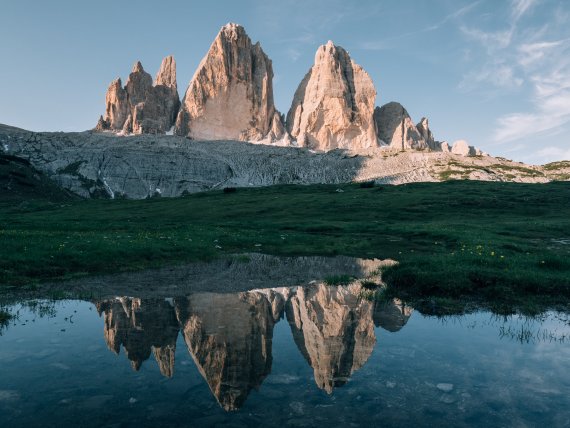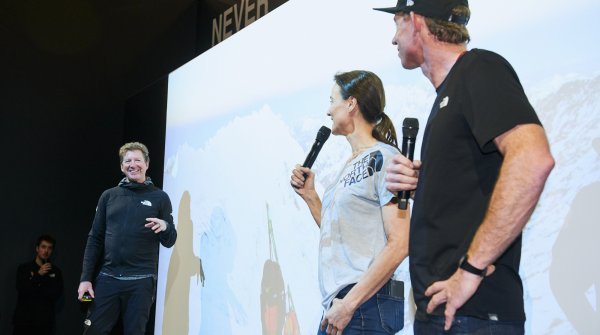The Dolomites are a centre of mountain sports. Mountaineering, trekking tours lasting several days or countless day hikes bring like-minded people together to clear their heads in the great outdoors and enjoy the magnificent mountain world with its gently rolling alpine pastures and rugged rock formations. There are tours for all levels, provided you have a minimum level of fitness. If you have some time, you can hike from hut to hut for days. For trekking fans, the region is therefore one of the most popular destinations in the world.
- Trekking on the Stabeler Höhenweg
- Trekking and Hiking at the Three Peaks
- Trekking on the Dolomites High Trail
This high-altitude trail deserves its name, because it is always hiked well above the 2,500-metre mark. The trail starts in the village of St. Johann in the Tauferer Ahrntal valley, with a church worth seeing and a mineral museum. From here, at an altitude of around 1,000 metres, the route follows a wide sweeping curve to Weißenbach. Three days and around 15 hours of walking time should be planned for this tour. You will spend the night at an altitude of over 2,900 metres in the Schwarzensteinhütte and, after crossing the Schwarzenbach, Mitterbach and Trattenbach valleys, in the Nevesjochhütte (Chemnitzer Hütte). The tour requires an excellent constitution, surefootedness and - depending on the weather conditions - also the safe use of ice axe and crampons.

For mountain lovers all over the world, the "Three Peaks" symbolise the mountain world of the Dolomites, as the striking silhouette of the peaks is often used as a motif for the region. Around the mountain peaks, UNESCO World Natural Heritage, leads a circular hiking trail with beautiful huts, which is even suitable for families. On the route, which leads over the Paternsattel with a magnificent view of the north walls of the Zinnen, there are barely 400 metres of altitude difference to overcome. The route could be completed in around three hours. Nevertheless, many mountaineers use it for a hut trekking adventure to enjoy the scenery a little longer and spend at least one night in one of the famous mountain huts - the Auronzo Hut, Lavaredo Hut and Dreizinnen Hut. Reservations are essential here.

The "Alta Via delle Dolomiti n. 1" is considered one of the most beautiful long-distance hiking trails in the Dolomites. It runs for around 150 kilometres from Braies Lake to Belluno at an altitude of between just under 1,500 and 2,800 metres. Depending on your constitution and mood, you will need between one and two weeks to cover the distance. The length of the daily stages can be chosen relatively freely due to the density of huts, and of course sections are also possible at any time. Since - with the exception of the Màrmol via ferrata between the Rifugio Pian de Fontana and Rifugio 7° Alpini - no climbing skills are required, the tour is recommended for all passionate mountain hikers. Thanks to the good signposting - a triangle with a 1 - no difficulties are to be expected in orientation either. Depending on the season, however, fog or fresh snow can occur, in which case caution is advised.
The trail starts at the Pragser Wildsee lake, where legend has it that the gateway to the underworld was once located, and which is now designated as a natural monument. From here, the trail leads via the Seekofel and Seneshütte huts to the Pederühütte hut, which for most trekking fans is the latest conclusion to the first day in the mountains. You should allow between six and eight hours of walking time, which also applies to the following daily stages, if you choose the following huts for overnight accommodation: Rifugio Monte Lagazuoi, Rifugio Monte da Lago, Rifugio A. Sonino al Coldai, Rifugio Vazzoler, Rifugio Pramperet, Rifugio Settimo Alpini. If you want to take a less sporty approach, you can split almost every day's stage into two. It is also possible and advisable to plan side trips - for example, right at the beginning to the Seekofel, which should be combined with an overnight stay in the Seekofelhütte.
The trail leads partly over scree and stony terrain, paved paths and extensive alpine meadows. In parts it goes steeply uphill. The landscape is characterised by rugged rocks and barren plateaus, interrupted again and again by mountain forests, scrub or meadows. This trekking tour is hard to beat in terms of natural diversity - it is no coincidence that it is considered a great classic.

 OutDoor by ISPOOutDoor in transition
OutDoor by ISPOOutDoor in transition
- Awards
- Mountain sports
- Bike
- Fitness
- Health
- ISPO Munich
- Running
- Brands
- Sustainability
- Olympia
- OutDoor
- Promotion
- Sports Business
- Textrends
- Triathlon
- Water sports
- Winter sports
- eSports
- SportsTech
- OutDoor by ISPO
- Heroes
- Transformation
- Sport Fashion
- Urban Culture
- Challenges of a CEO
- Trade fairs
- Sports
- Find the Balance
- Product reviews
- Newsletter Exclusive Area
- Magazine






